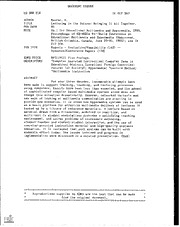
ERIC ED388218: Lecturing in the Future: Bringing It All Together. PDF
Preview ERIC ED388218: Lecturing in the Future: Bringing It All Together.
DOCUMENT RESUME ED 388 218 IR 017 367 AUTHOR Maurer, H. TITLE Lecturing in the Future: Bringing It All Together. PUB DATE 94 NOTE 2p.; In: Educational Multimedia and Hypermedia, 1994. Proceedings of ED-MEDIA 94--World Conference on Educational Multimedia and Hypermedia (Vancouver, British Columbia, Canada, June 25-30, 1994); see IR 017 359. PUB TYPE Reports Evaluative/Feasibility (142) '- Speeches/Conference Papers (150) EDRS PRICE MF01/PC01 Plus Postage. DESCRIPTORS *Computer Assisted Instruct:on; Computer Uses in Education; Districe Education; Foreign Countries; Futures (of Society); Hypermedia; *Lecture Method; *Multimedia Instruction ABSTRACT For over three decades, innumerable attempts have been made to support training, teaching, and lecturing processes using computers. Results have been less than expected, and the advent of sophisticated computer based multimedia systems alone does not change this situation dramatically. However, networked variants and new ways of looking at multimedia communication are starting to provide new scenarios. It is shown how hypermedia systems can be used as a basic platform for effective multimedia delivery of lectures if backed up by a library of reference materials. A lecture based on material drawn from a fileserver, modified in real-time, and multi-cast to student workstations provides a satisfying teaching environment, and solves problems of courseware authoring, student-teacher and student-student interaction, and the use of comiuter-assisted instruction material and high-quality distance education. It is contended that.such systems can be built with moderate effort today. The issues involved and progress in implementation were discussed in a related presentation. (MAS) **************,--Y.*************************************************** Reproductions supplied by EDRS are the best that can be made * * from the original document. *********************************************************************** Lecturing in the Future: Bringing It All Together U.S. DEPARTMENT OF EDUCATION Office 04 EduciltrOnal Research ana improvement EDUCATIONAL RESOURCES INFORMATION CENTER (ERIC) o This dOCtment UER H. M.AR nas been reproduceO received hem the person or organization oginating it Auckland/New Zealand Graz University of Technology/Austria and University of E", Minor changes have be en made to improve reproduction duality email: hmawer®iicm.tu-graz.ac.at Points of view or opinions staled in IhtSCIOCu. men) do not necessarity represent official OERI posiliOn Or pOky 00 For over three decades innumerable attempts have been made to support training, teaching and lecturing oo processes using computers. Despite the huge amounts of funding, energy and enthusiam that have been oo poured into such undertakings, results have often been less than expected. This is true if one looks at stand- alone CAI applications of most varieties of client-server approaches within LANs such as COSTOC described in [Huber 1989], is true of many simulation and intelligent tutoring systems, and also applies to numerous attempts employing high-tech teleteaching. The advent of sophisticated computer based multi-media systems alone does not change this situation dramatically; however, networked variants thereof and new ways of looking at the whole multi-media communication process are starting to provide new scenarios and might well result in the long awaited breakthrough ([Maurer 1992], [Carlson 1992], [Lennon 1994a]). In this talk, we show how modern hypermedia systems such as Hyper-G [Kappe 1993] can be used as a basic platform for effective multi-media delivery of lectures if backed up by a library of reference material ([Calude 1994], [Maurer 1994]). Expanding on ideas presented in [Lennon 1994b], we explain how a lecture based on material drawn from a fileserver, modified in real-time if necessary and multi-cast to student workstations not only provides a most satisfying teaching envrionment but thatusing a number of additional featuresit at the same time solves long open problems of courseware authoring, student-teacher and student-student interaction, and the use of CAI material and high-quality distance teaching. As a most surprising aspect, we claim that courseware authoring "on the fly" is starting to become almost a reality. We contend that such systems can be built with moderate effort today. We report on the issues involved and on progress made in implementing such systems, thus demonstrating that our ideas are indeed more than "vapour-ware". If the above sounds too good to be true you better come to the presentation so that we can try to convince you of the feasibility of all important issues involved! References Carlson, P., & Maurer, H. (1992). Computer Visualization, a Missing Organ and a Cyber-Equivalency. Collegiate Microcomputers 10 (2), 110-116. Calude, C., Maurer, H., & Salomaa, A. (1994). JUCS - the Journal of Universal Computer Science. Report. Department of Computer Science, Unviersity of Auckland; submitted for publication elsewhere. Huber, F., Makedon, F., & Maurer, H. (1989). HyperCOSTOC a Comprehensive Computer-Based Teaching Support System. J.MCA 12, 293-317. Kappe, F., Maurer, H., & Sherbakov, N. (1993). Hyper-G: A Universa-1 Hypermedia System; Journal of Educational Multimedia and Hypermedia 2 (1), 39-66. Lennon, J., & Maurer, H. (1994). Lecturing Technology: A Future with Hypermedia. Report, Department of Computer Science, University of Auckland (1993); to appear in:J. Educational Technology (1994). Lennon, J., & Maurer, H. (1994). MUSLI - A MUlti-Sensory Language Interface; Educational Multimedia and Hypermedia Annual, 1994, Association for the Advancement of Computing in Education, Charlottesville, VA USA. Maurer, H. (1992). Why Hypermedia systems are Important. LNCS 602, Springer Pub.Co., Heidelberg/New York, 1-15. Maurer, H., Muelner, 11., & Schneider, A. (1994). An Electronic Library and its Ramifications. Report 382, IIG Graz (1994); submitted for publication elsewhere. PERMISSION TO REPRODUCE THIS 46 MATERIAL HAS BEEN GRANTED BY Gary H. Marks 0 2 TO THE EDUCATIONAL RESOURCES BEST COPY AVAILABLE INFORMATION CENTER (ERIC)."
